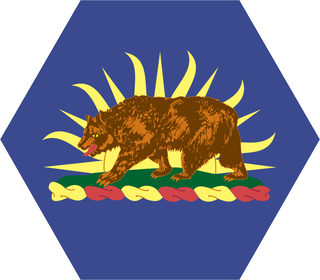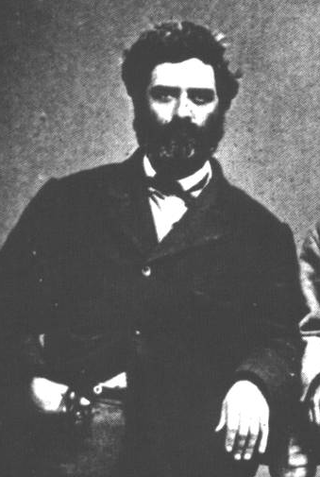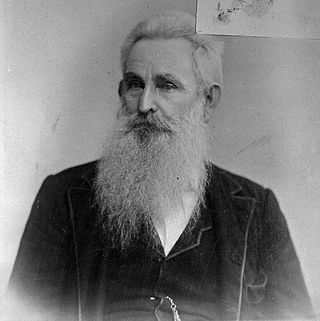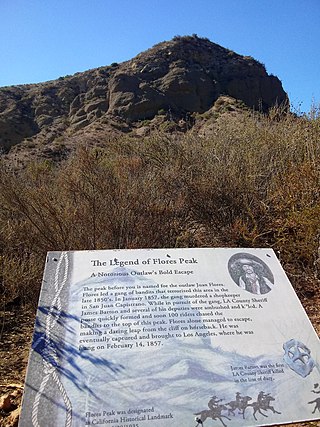
Tiburcio Vásquez was a Californio bandido who was active in California from 1854 to 1874. The Vasquez Rocks, 40 miles (64 km) north of Los Angeles, were one of his many hideouts and are named after him.

The Battle of San Pasqual, also spelled San Pascual, was a military encounter that occurred during the Mexican–American War in what is now the San Pasqual Valley community of the city of San Diego, California. The series of military skirmishes ended with both sides claiming victory, and the victor of the battle is still debated. On December 6 and December 7, 1846, General Stephen W. Kearny's US Army of the West, along with a small detachment of the California Battalion led by a Marine Lieutenant, engaged a small contingent of Californios and their Presidial Lancers Los Galgos, led by Major Andrés Pico. After U.S. reinforcements arrived, Kearny's troops were able to reach San Diego.

California's involvement in the American Civil War included sending gold east to support the war effort, recruiting volunteer combat units to replace regular U.S. Army units sent east, in the area west of the Rocky Mountains, maintaining and building numerous camps and fortifications, suppressing secessionist activity and securing the New Mexico Territory against the Confederacy. The State of California did not send its units east, but many citizens traveled east and joined the Union Army there, some of whom became famous.
General José María Flores was a Captain in the Mexican Army and was a member of la otra banda. He was appointed Governor and Comandante Generalpro tem of Alta California from November 1846 to January 1847, and defended California against the Americans during the Mexican–American War.

The California Army National Guard is one of three components of the California National Guard, a reserve of the United States Army, and part of the National Guard of the United States. The California Army National Guard is composed of 18,450 soldiers. Nationwide, the Army National Guard comprises approximately one half of the US Army's available combat forces and approximately one third of its support organization. National coordination of various state National Guard units are maintained through the National Guard Bureau.
Juan Flores was a 19th-century Californio bandit who, with Pancho Daniel, led an outlaw gang known as "las Manillas" and later as the Flores Daniel Gang, throughout Southern California during 1856-1857. Although regarded by historians as a thief and outlaw, Flores was considered among Mexican-Americans as a folk hero akin to Jesse James and who was thought of as a defender against vigilante movements in the years following the American settlement of California and its incorporation into the United States. However, the activities of Flores and other insurrectos such as Salomon Pico and Joaquín Murrieta against American and foreign-born settlers not only created long-lasting suspicion and hostility towards Mexican-Americans but also divided the traditional Spanish class structures of the Californios and the poorer peasants as well.
Jack Powers, whose real name was John A. Power, was an Irish-born American outlaw who emigrated to New York as a child and later served as a volunteer soldier in the Mexican–American War in the garrison of Santa Barbara, California. During the California Gold Rush, he was a well-known professional gambler and a famed horseman in the gold camps as well as in San Francisco, Santa Barbara and Los Angeles.
The California Battalion was formed during the Mexican–American War (1846–1848) in present-day California, United States. It was led by U.S. Army Brevet Lieutenant Colonel John C. Frémont and composed of his cartographers, scouts and hunters and the California Volunteer Militia formed after the Bear Flag Revolt. The battalion's formation was officially authorized by Commodore Robert F. Stockton, commanding officer of the U.S. Navy Pacific Squadron.

Tomas Avila Sanchez (1826–1882), soldier, sheriff and public official, was on the Los Angeles County, California, Board of Supervisors and was a member of the Los Angeles Common Council, the legislative branch of the city.
Salomón María Simeon Pico was a Californio, a cousin of former governor Pío Pico, who led a bandit band in the early years following the Mexican–American War in the counties of the central coast of California. Pico was considered by some Californios to be a patriot who opposed the American conquest of Alta California and its subsequent incorporation into the United States. He was hated for his banditry by the newly arrived Americans but protected by some Californios as a defender of his people.
Tom McCauley, better known by his alias James Henry or Jim Henry, was one of the many California Gold Rush criminals later a leader of the Mason Henry Gang.

Andrew Jackson King (1833–1923), or A. J. King, was a lawman, lawyer, legislator and judge in 19th Century Los Angeles County, California.

Bethel Coopwood (1827–1907) was born in Alabama, and moved to Texas and was a soldier in the Mexican–American War and an officer in the Confederate Army in the American Civil War. He was a lawyer, judge, and later a historian.
James R. Barton was the second sheriff of Los Angeles County, California, and the first to die in office, in the line of duty.
Pancho Daniel (?–1858) was a Californio bandit, leader of the Flores Daniel Gang who was lynched in November 1858 while awaiting trial for his involvement in the murder of Los Angeles County Sheriff James R. Barton.
Flores Daniel Gang, was an outlaw gang also known as "las Manillas", throughout Southern California during 1856-1857. Californio's Juan Flores and Pancho Daniel. Contemporary newspaper accounts of las Manillas all reported that the leader of las Manillas was originally Pancho Daniel, but that Juan Flores assumed the leadership role after Daniel was injured in the Barton ambush. According to the account of Harris Newmark, Flores had been sent to prison for horse-stealing and was just another member of the gang.

Flores Peak is a mountain peak, overlooking the confluence Harding Canyon and Modjeska Canyon, within the Tucker Wildlife Sanctuary in Orange County, California. It rises to an elevation of 1,834 feet. It is named for Juan Flores of the Flores Daniel Gang.
Jose Antonio Garcia (1836–1858) was a Californio bandit, born in Santa Barbara, Alta California. He was suspected by the San Luis Obispo Vigilance Committee of being part of the gang of Pio Linares, and he was hung after making a confession exposing other members and the leadership of the gang as the participants in an 1857 robbery and murder of two French Basque cattlemen.